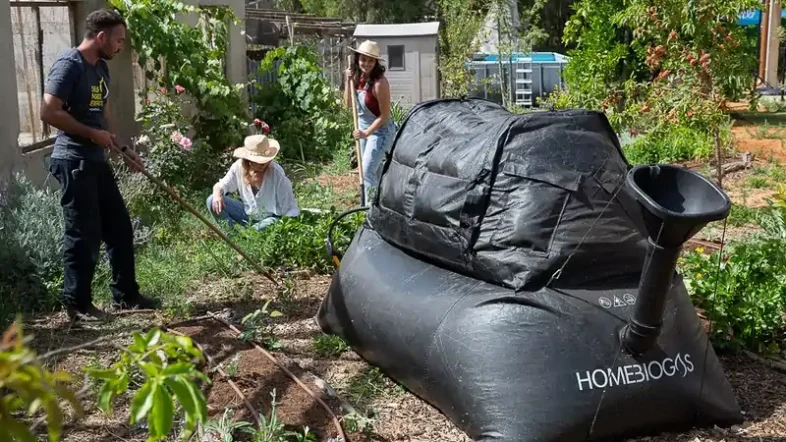Hey there! If you're considering setting up and using a home biogas system or you've just started using one, welcome to the club!
After a few months of using our home biogas plant, we've learned a few things that I wish we had known from the beginning. It's been a great journey so far, but there are a few surprises we encountered along the way. Here are some tips that might help you avoid the same pitfalls we did.
1. Managing the Liquid Fertilizer Output

One of the first things you'll notice when you start using your home biogas system is the amount of liquid fertilizer it produces. We get about a litre a day. That might not sound like much, but trust me, it adds up quickly! Initially, we stored it in an open barrel, but that turned out to be a mistake. The barrel filled up fast, mosquitoes loved it, and it became too heavy to move around easily.
Tip: Use a container with a closed lid and a tap. ensure that the tap is high enough to allow the tap to drain into a watering can. This makes it super easy to manage. You can quickly fill up a watering can, and even the kids can help out! It also keeps mosquitoes at bay and allows you to see how much fertilizer you have at a glance.
2. Understand Your Food Waste Output
Before we set up our biogas system, we assumed we were generating 3–4 kilos of food waste a day. But in reality, it was far less—about one to one and a half litres a day. This means our system isn't producing as much gas as it could because it's underfed.
Tip: Before investing in a home biogas system, take a week to collect and weigh your food scraps. This will give you a realistic idea of how much biogas you can generate and help you choose the right size system. If you find that you're not generating enough food waste, consider other organic materials like manure. If you have large animals like horses or cattle, their manure can be easily scooped, mixed into a slurry, and added to the system to boost gas production while using a home biogas system.
3. Set Realistic Expectations for Gas Storage and Usage
 We’ve been using the single burner that came with our biogas system for about four months. It has seven little burners inside the ring, and while it works well, there’s a catch—it only lasts about two and a half hours of continuous use before the gas runs out.
We’ve been using the single burner that came with our biogas system for about four months. It has seven little burners inside the ring, and while it works well, there’s a catch—it only lasts about two and a half hours of continuous use before the gas runs out.
We expected it to store more gas for longer use, but the top bladder, no matter how full, only gives us a couple of hours of cooking time.
Tip: Before you start using a home biogas system, be clear about how you plan to use your system. If you’re only looking to use it for small tasks like boiling water once a day, it should work fine. However, if you’re hoping to use it for daily meal preparation for a family, you may need to feed the system more or consider a larger setup. The amount of food waste you can feed it will directly impact how much gas it produces.
4. Plan Ahead and Do Your Research
I’ll be the first to admit—I jumped into this project without doing as much research and planning as I should have. While everything is working fine, it’s a bit different from what I was expecting. The unit itself is great, but understanding how much gas it produces and how to manage the outputs better would have made the transition smoother.
Tip: Don’t make the same mistake I did! Take the time to research, plan, and understand what you need out of your biogas system. Consider your daily needs, how much waste you generate, and how you’ll use the gas and fertilizer. This will save you from surprises down the line.
Using a Home Biogas Plant: Final Thoughts
Using a home biogas system is a fantastic way to manage organic waste and produce renewable energy at home. But like any new venture, it comes with a learning curve.
I hope these tips help you get the most out of your system and avoid some of the bumps we encountered along the way. Happy biogas-ing!
Thanks for reading, and if you’re thinking about setting up a biogas plant at home, I hope this has been helpful. Remember, a little bit of planning goes a long way!
Free Home Biogas Expert Cheat SheetMore General Home Biogas Plant Operating Tips
Here are some more tips for using a home biogas plant:
5. What to feed it: Home biogas plants can be fed a variety of organic waste, including fruit, dairy, eggs, meats, cooking oil, and more. You can also feed it rotten or mouldy food, but avoid feeding it large amounts of citrus fruit skin.
6. Water ratio: The recommended ratio of water to scraps is 1:1 unless the manufacturer provides different instructions.
7. Gas production: The biogas produced can be used for cooking, heating, or generating electricity.
8. Temperature: The biogas system needs to be kept warm to make gas.
9. pH levels: If the pH levels stray from the ideal neutral zone, the gas-producing organisms will go dormant until the pH levels are corrected.
10. Installation: Home biogas systems are easy to install, and should be outside for obvious reasons of gas safety in confined spaces, but especially important outside the tropics is to choose a warm sheltered location with plenty of sunlight to warm the digester.
11. Add in Other Wastes: While most just feed their kitchen waste into their digester there may be an opportunity to raise gas output by the regular addition of other organic waste types. So, if you have a smallholding with cows or other livestock, adding their manure can raise gas outputs.
12.Waste management: Home biogas plants are a sustainable way to manage waste and reduce the degree of climate-warming methane discharges from landfills.
Free Home Biogas Expert Cheat SheetImage attribution (unaltered):
- A black flexible plastic HomeBiogas biogas plant (Featured image) CC BY-NC 2.0
- Lady pouring kitchen waste into digester (2 images) CC BY-NC 2.0





I wish I’d known about the importance of pH levels in the digester when I started. It could have saved me some troubleshooting headaches.